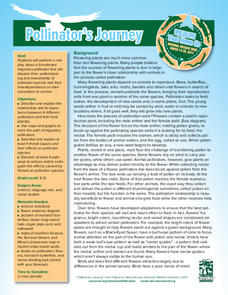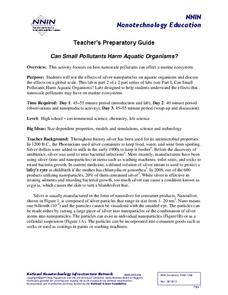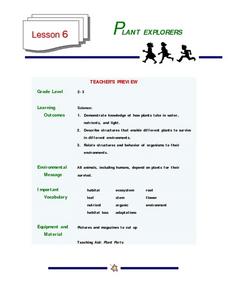National Wildlife Federation
Pollinator's Journey: Grades 9-12
Gain a deeper understanding of migratory pollinators. After studying about pollinators and their effects on flowering plants, learners hear a story about the migration of Monarch butterflies and bats in the Sonoma Desert. Small groups...
Teach Engineering
Design Inspired by Nature
Let nature guide your engineering designs. By taking apart a flower, pupils learn about reverse engineering. They use the results to brainstorm designs for new products or ideas. This is the seventh installment of a nine-part Life...
Roald Dahl
The Twits - The House, the Tree and the Monkey Cage
A house with no windows and a garden full of stinging nettles make the perfect home for Mr. and Mrs. Twit. The seventh activity in an 11-part unit designed to accompany The Twits by Roald Dahl takes a closer look at the Twits' home...
NASA
Exploring the Moon
Can plants grow on the moon? The second instructional activity in a five-part series has pupils explore the resources available on the moon to determine if plant life is possible. They use lava rocks as their soil and draw conclusions...
Chicago Botanic Garden
Nature Walk and Ecosystem Introduction
A food web has no organism higher than a tertiary consumer because there wouldn't be enough energy left to sustain them. The fourth installment in a seven-part series begins with a nature walk to get pupils thinking about their...
Foundation for Water & Energy Education
How Can Work Be Done with Water Power? Activity B
In this second of three activities, energy engineers plan and create a hydropower dam as they learn how hydroelectric power plants generate electricity. A hydropower puzzle is also included, which can be worked on by teams that finish...
Curated OER
Life Cycle of Trees
Turn your students into young tree-tectives with this fun science investigation into the life of trees. To begin, a class volunteer gets dressed up in a tree costume as the different parts of trees are introduced. Then, the class learns...
LABScI
The Digestive System: Where Does Food Go?
Would you believe that your digestive system stretches to five times your height?! Help your pupils to understand this relationship as they work through the laboratory exercise. The first instructional activity of a 12-part series is a...
National Nanotechnology Infrastructure Network
Can Small Pollutants Harm Aquatic Organisms?
Nanoparticles have toxic effects on plant and animal life—even though you can't see them. The second lesson of a two-part series has young scientists conduct an experiment that exposes plant and animals to nanoparticle pollutants. They...
Chicago Botanic Garden
Preparing for Project BudBurst
Adopt a plant and get to know its phenophases. The third instructional activity in a six-part series combines plant identification and phenology. Pupils begin by creating their own field guides to learn about the features and...
Curated OER
Raven Chapter 10 Guided Notes: Photosynthesis
Kim B. Foglia has designed a comprehensive series of AP biology worksheets. This one focuses learners on the progression of photosynthesis in plants. In this assignment, they identify structures and steps on high-quality diagrams, use...
Little Bins for Little Hands
St. Patrick's Day Challenge Cards
Nineteen cards offer an assortment of St. Patrick's Day-themed STEM activities. Scholars choose from a variety of cards to take part in activities such as building coin towers, growing green carnations, tying a celtic knot, and more!
Science Matters
Formative Assessment #6: Photosynthesis Cellular Respiration
You know you taught it, but did they learn it!?! A quick formative assessment asks pupils to describe both photosynthesis and cellular respiration before showing how they relate to each other. The lesson marks the 20th lesson in a...
Alabama Wildlife Federation
Leaf Creatures
The structure of a leaf reveals a lot about the plant it comes from. Young scholars collect and prepare leaves for comparison. After pressing the leaves, they identify the different parts and then use the leaves to complete an art project.
Chicago Botanic Garden
Ecological Mismatches
Modeling is a powerful teaching tool. The final installment in a six-part series has pupils complete an activity to model a food web and discover the interconnected relationships in an ecosystem. They then read about changes in migratory...
Curated OER
A Pressing Project
Students create a collection of pressed plants. In this plant lesson, students use newspaper, plywood, and a rubberband to press plants they previously collected.
Curated OER
Plant Explorers
Students investigate how plants take in water, nutrients, and light. They create artwork showing how plants survive in different environments.
Curated OER
Making Pretzels
Young scholars explore how people use plants for food. They use pretzels to see how wheat can be turned into food.
Curated OER
Will It Grow?
Fifth graders conduct experiments involving plants. In this science instructional activity, 5th graders design an experiment involving plants. Students use the scientific method to design their experiments.
Curated OER
What is a Seed?
Students share experiences they have had with different types of seeds. After being read a story, they are given a lima bean in which they split apart and examine the inside. To end the lesson, they share their own ideas on how they...
Curated OER
Create a Food Chain
Students discover the connection between plants and animals by discussing simple food chains. Students explore what may happen when parts of a food chain are removed. Students wrap up the lesson by writing a story about a food chain.
Cmassengale
Photosynthesis Diagrams Worksheet
Help young botanists get to the root of photosynthesis with this series of worksheets. By completing these diagrams, students demonstrate their understanding of the biological structures and chemical reactions that make this amazing...
Curated OER
Chocolate Fever
Students study plants in the rainforest. They complete a variety of activities surrounding the subject of chocolate. They create new candy bars, invent learning games and write poetry--all focusing on chocolate.
Curated OER
Your Day as a Cycle
Fourth graders examine a variety of cycles. They take a look at life cycles of plants and animals, the cycle of the moon and tides, and other sequences of events in their daily lives. An interesting part of the instructional activity is...
Other popular searches
- Parts of Plants
- Identifying Parts of Plants
- Parts of Plants Video
- Parts of Plants Organizer
- Reproductive Parts of Plants
- Parts of Plants Cell
- Comparing Parts of Plants
- Parts of Plants Mnemonic
- Edible Parts of Plants
- Comparing Plants Plant Parts
- Parts of a Plants
- Plants Parts for Food

























